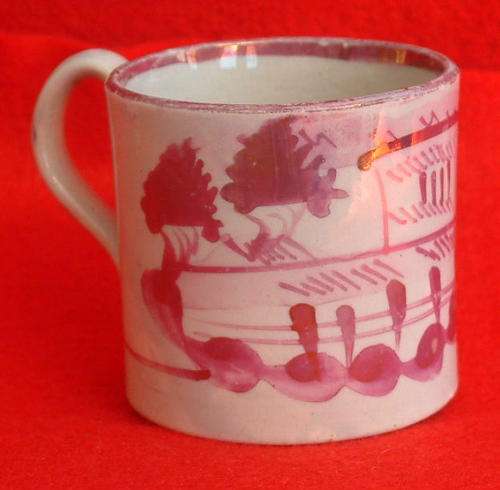Antique Sunderland Pink Lustreware Coffee Can Circa 1820 - Ref. C7
Lustreware is type of pottery with a metallic glaze that gives the effect of iridescence, produced by a thin metal glaze reduced by chemical agents. The final glaze lustre may be composed of one or more metallic ingredients. The origin of the method is old. The early Persians produced lustrious pottery in the early 13th century and this process could have been copied by Europe. Pink Lustre was developed in England around the 1790's when some potteries found that by applying gold to the glaze and heating at a lower temperature, it turned a pink color. Early pieces can be identified as being of a 'soft paste', (a virtually opaque clay) and, if examined carefully, they show a 'blue'tone where the glaze is thicker,like in the crevice on the base of the article or where the handle joins the cup or mug.
Although Sunderland, which is in the North East of England, did not have its own deposits of clay, this was brought in as ballast by ships and, consequently, did not cost much to import.Several potteries were to be found along the banks of the River Wear, but, the earliest known pottery was established in 1750.Typical of the day, many children from the age of eight years old, were employed.


This pink Lustreware pottery became very popular throughout England and much was exported to Europe and America. Early pieces were hand-painted as an overglaze and were quite simple in their designs.Later pieces were transfer-printed and then hand clobbered. Lustreware was also used by many other potteries in Staffordshire, such as Wedgwood and Spode..
The Coffee Can, as shown above, dates to around the 1820 era. It shows a simple, hand-painted lustre design incorporating a rather abstract design (which may be a building with some trees) on a cream coloured base. The pottery is quite granular in appearance with typical small black spots caused by the coal dust from the coal fired kilns.The glazing is quite matt and shows typical bubbles.
There is some loss of the pink lustre around the rim and a hairline crack running down the front of the mug. All in all, it is in good condition, considering its age and that this was used as an everyday article.
Height - 5.50 cm
Diameter -5.60 cm
Please note, I am NOT a qualified archaeologist/antiquarian and the description I have given is based on research of the subject.
This is a genuine antique. The classification of an 'antique' is that it should be 100 years old, OR MORE. There are many articles being offered as 'antiques' when, clearly, they are not.
Price R300.00
Post R45.00
Terms: We offer a strict three-day approval period from the date the parcel reaches you. Refunds/credits are based on the cost of the article, NOT including delivery charges. Please advise us within this period whether you would like to return any article for a refund/credit. Although we pride ourselves in our packing, the buyer remains responsible for loss, non-arrival or damage to goods being sent to, or returned.





